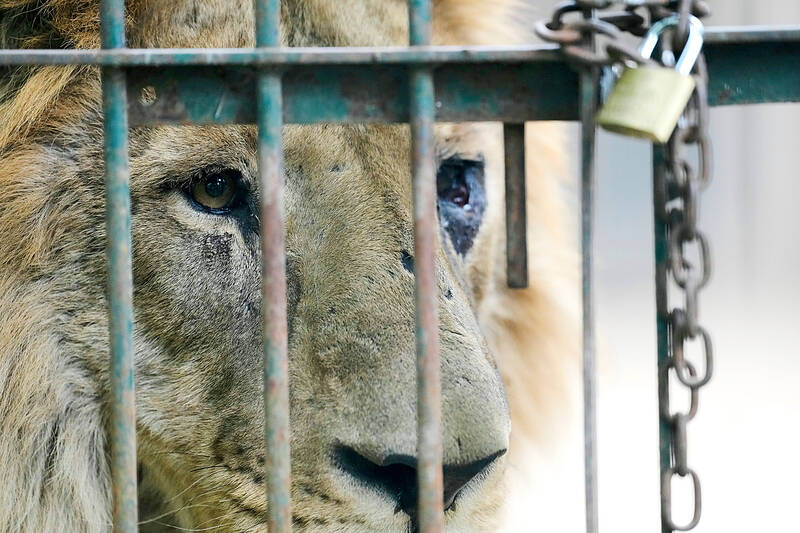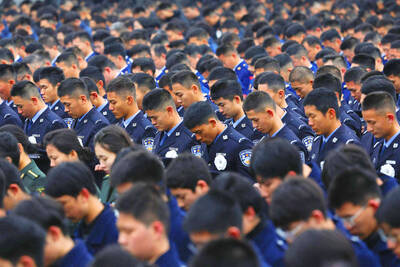Lions, tigers and bears that managed to survive in substandard conditions at a now-shuttered zoo on the outskirts of Buenos Aires paced weakly in their claustrophobic cages on Thursday, waiting their turn to receive urgent veterinary care for the first time in years.
The 62 big cats and two brown bears were being evaluated and treated before their eventual transfer to vast wildlife sanctuaries abroad — among the most complex animal rescues undertaken in Argentina after the country’s recent arrangement with an international animal welfare organization.
Argentine authorities in 2020 shut down the Lujan Zoo — famous for letting visitors handle and pose for pictures with tigers and lions — over mounting safety concerns.

Photo: AP
However, the plight of the captive cats there only worsened. For the past five years, the animals were sustained by little more than a few loyal zookeepers who, despite having lost their jobs at Lujan, took it upon themselves to feed and care for the stranded lions and tigers left behind.
Most did not make it.
When Four Paws, an animal rights charity, first visited the zoo in 2023, caretakers counted 112 lions and tigers — already down from the 136 big cats housed in the zoo at the time of its closure.
Two years on, almost half of the animals have succumbed to illnesses from poor nutrition, wounds from fights with animals they would never encounter in the wild, infections from lack of medical attention and organ failure from the stress of living in such cramped conditions.
“It was really shocking,” organization chief program officer Luciana D’Abramo said, pointing to a 3m2 cage crammed with seven lions.
Next door, two Asian tigers shared a tiny cage with two African lions — a “social composition that would never be found in nature,” D’Abramo said.
A single lion typically gets 1 hectare to itself at Four Paws’ sanctuaries around the world.
After striking an agreement with Argentina’s government earlier this year, Four Paws took over responsibility for the surviving wild animals in Lujan last month.
Amir Khalil, the veterinarian leading the group’s emergency mission said that “the number of animals and the conditions where they are kept make this a much bigger challenge,” adding that it was one of their biggest missions worldwide.
Veterinarians and experts from the organization were scrambling around the derelict zoo to assess the animals one by one. Most had not been vaccinated, sterilized or microchipped for identification.
The team whisked sedated lions and tigers onto operating tables, dispensing nutrients, antibiotics and doses of pain medication via intravenous drips.
The quick checkups frequently transformed into emergency surgeries. One tiger was treated for a bleeding gash in its tail last week and a lioness for a vaginal tumor on Thursday. Several tigers and lions needed root canals to repair infected molars that had been broken on the steel cage bars.
Others received treatment for claws that had grown inward from walking too much on unnatural, plank flooring in the enclosures.
After evaluating each animal, Four Paws would arrange for their transfer to more expansive, natural homes around the world.
Some Argentine zookeepers who spent decades feeding and caring for the big cats say they are happy to see Four Paws improving the conditions, but there was also a sense of nostalgia for how things were.
“It used to be a very popular place... I’ve seen people cry because they could touch a lion or feed a tiger with a bottle,” said Alberto Diaz, who spent 27 years working with the wild cats at the Lujan Zoo.

PARLIAMENT CHAOS: Police forcibly removed Brazilian Deputy Glauber Braga after he called the legislation part of a ‘coup offensive’ and occupied the speaker’s chair Brazil’s lower house of Congress early yesterday approved a bill that could slash former Brazilian president Jair Bolsonaro’s prison sentence for plotting a coup, after efforts by a lawmaker to disrupt the proceedings sparked chaos in parliament. Bolsonaro has been serving a 27-year term since last month after his conviction for a scheme to stop Brazilian President Luiz Inacio Lula da Silva from taking office after the 2022 election. Lawmakers had been discussing a bill that would significantly reduce sentences for several crimes, including attempting a coup d’etat — opening up the prospect that Bolsonaro, 70, could have his sentence cut to

China yesterday held a low-key memorial ceremony for the 1937 Nanjing Massacre, with Chinese President Xi Jinping (習近平) not attending, despite a diplomatic crisis between Beijing and Tokyo over Taiwan. Beijing has raged at Tokyo since Japanese Prime Minister Sanae Takaichi last month said that a hypothetical Chinese attack on Taiwan could trigger a military response from Japan. China and Japan have long sparred over their painful history. China consistently reminds its people of the 1937 Nanjing Massacre, in which it says Japanese troops killed 300,000 people in what was then its capital. A post-World War II Allied tribunal put the death toll

‘UNWAVERING ALLIANCE’: The US Department of State said that China’s actions during military drills with Russia were not conducive to regional peace and stability The US on Tuesday criticized China over alleged radar deployments against Japanese military aircraft during a training exercise last week, while Tokyo and Seoul yesterday scrambled jets after Chinese and Russian military aircraft conducted joint patrols near the two countries. The incidents came after Japanese Prime Minister Sanae Takaichi triggered a dispute with Beijing last month with her remarks on how Tokyo might react to a hypothetical Chinese attack on Taiwan. “China’s actions are not conducive to regional peace and stability,” a US Department of State spokesperson said late on Tuesday, referring to the radar incident. “The US-Japan alliance is stronger and more

FALLEN: The nine soldiers who were killed while carrying out combat and engineering tasks in Russia were given the title of Hero of the Democratic People’s Republic of Korea North Korean leader Kim Jong-un attended a welcoming ceremony for an army engineering unit that had returned home after carrying out duties in Russia, North Korean state media KCNA reported on Saturday. In a speech carried by KCNA, Kim praised officers and soldiers of the 528th Regiment of Engineers of the Korean People’s Army (KPA) for “heroic” conduct and “mass heroism” in fulfilling orders issued by the ruling Workers’ Party of Korea during a 120-day overseas deployment. Video footage released by North Korea showed uniformed soldiers disembarking from an aircraft, Kim hugging a soldier seated in a wheelchair, and soldiers and officials